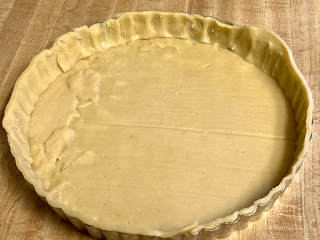23 May 2023
Recipe from Cook's Illustrated, May 2022
I have been interested in making fruit hand pies for some time, but I have never gotten around to it. The small size is appealing when there are just two of us to eat them as is the convenience of being able to eat them by hand with no need for utensils. So when a recipe appeared in CI last year I made a note of it. It finally made it to the top of the list.
Directions were provided for several fillings using different fruits, though they were very similar. I used the peach filling recipe but substituted frozen mixed berries (blueberry, blackberry, and raspberry) which we had on hand. The only change I made was to omit lemon zest. Sugar, salt, and thawed berries were combined in a sauce pan and one-third of them were mashed with a potato masher. The mixture was cooked to dissolve the sugar. Lemon juice and cornstarch were mixed together in a small bowl then added to the berry mixture and simmered until thickened. The fruit mixture was transferred to a bowl and set aside in the refrigerator.
Creation of the dough had some unique aspects. AP flour, sugar, and salt were placed in a 1-gallon zipper-lock bag and shaken to combine. Unsalted butter that had been cut into thin planks was added to the bag which was sealed and shaken. (The recipe said cut sticks of butter in half lengthwise. Our butter sticks are shorter and thicker so I cut them into thirds lengthwise.) A rolling pin was used to flatten the butter into large flakes. The bag was shaken and rolled again until most of the flour was incorporated into the flour mixture. This was emptied into a large bowl and ice water was mixed into the dough until combined. This was rolled into a 15x10-inch rectangle then folded into thirds. The dough was again rolled out and folded into thirds. The dough was divided in half and refrigerated for 90 minutes. It was then rolled into a 17x9-inch rectangle and lines were painted on using egg wash. The fruit filling was added to the squares made with the egg wash and the dough was folded over the fruit, like ravioli, using the egg wash as glue to close each of the raw hand pies. These were trimmed with a pizza cutter, coated with egg wash, and baked. Some were sprinkled with turbinado sugar
We enjoyed these little pies. A few times we each ate a whole pie but we eventually decided that sharing one made more sense for us. When they were fresh the crust was very flaky and crispy. The filling was good, my substitutions worked well. These pies have more crust for the amount of filling than a traditional pie. The crust in particular does not keep well as it loses its crispiness and flakiness; this was not a surprise. I enjoyed making them, partly for their novelty. I don't know if I will make them again instead of a regular pie, time will tell.














































